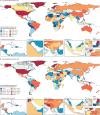Global, regional, and national burden of spinal cord injury, 1990-2019: a systematic analysis for the Global Burden of Disease Study 2019
- PMID: 37863591
- PMCID: PMC10584692
- DOI: 10.1016/S1474-4422(23)00287-9
Global, regional, and national burden of spinal cord injury, 1990-2019: a systematic analysis for the Global Burden of Disease Study 2019
Erratum in
-
Correction to Lancet Neurol 2023; 22: 1026-47.Lancet Neurol. 2024 Apr;23(4):e8. doi: 10.1016/S1474-4422(24)00095-4. Lancet Neurol. 2024. PMID: 38508840 Free PMC article. No abstract available.
Abstract
Background: Spinal cord injury (SCI) is a major cause of health loss due to premature mortality and long-term disability. We aimed to report on the global, regional, and national incidence, prevalence, and years of life lived with disability (YLDs) for SCI from 1990 to 2019, using data from the Global Burden of Diseases, Injuries, and Risk Factors Study (GBD) 2019.
Methods: Using GBD 2019 data pooled in DisMod-MR 2.1, a Bayesian meta-regression tool, we systematically derived numbers and age-standardised rate changes with 95% uncertainty intervals (95% UIs) for the incidence, prevalence, and YLDs for SCI from 1990 to 2019 for the whole world, 21 GBD regions, and 204 countries and territories. We report trends based on age, sex, year, cause of injury, and level of injury.
Findings: Globally, 20·6 million (95% UI 18·9 to 23·6) individuals were living with SCI in 2019. The incidence of SCI was 0·9 million (0·7 to 1·2) cases with an estimated 6·2 million (4·5 to 8·2) YLDs. SCI rates increased substantially from 1990 to 2019 for global prevalence (81·5%, 74·2 to 87·1), incidence (52·7%, 30·3 to 69·8), and YLDs (65·4%, 56·3 to 76·0). However, global age-standardised rates per 100 000 population showed small changes in prevalence (5·8%, 2·6 to 9·5), incidence (-6·1%, -17·2 to 1·5), and YLDs (-1·5%, -5·5 to 3·2). Data for 2019 shows that the incidence of SCI increases sharply until age 15-19 years, where it remains reasonably constant until 85 years of age and older. By contrast, prevalence and YLDs showed similar patterns to each other, with one peak at around age 45-54 years. The incidence, prevalence, and YLDs of SCI have consistently been higher in men than in women globally, with a slight and steady increase for both men and women from 1990 to 2019. Between 1990 and 2019, SCI at neck level was more common than SCI below neck level in terms of incidence (492 thousand [354 to 675] vs 417 thousand [290 to 585]), prevalence (10·8 million [9·5 to 13·9] vs 9·7 million [9·2 to 10·4]), and YLDs (4·2 million [3·0 to 5·8] vs 1·9 million [1·3 to 2·5]). Falls (477 thousand [327 to 683] cases) and road injuries (230 thousand [122 to 389] cases) were the two leading causes of SCI globally in 2019.
Interpretation: Although age-standardised rates of incidence, prevalence, and YLDs for SCI changed only slightly, absolute counts increased substantially from 1990 to 2019. Geographical heterogeneity in demographic, spatial, and temporal patterns of SCI, at both the national and regional levels, should be considered by policy makers aiming to reduce the burden of SCI.
Funding: Bill & Melinda Gates Foundation.
Copyright © 2023 The Author(s). Published by Elsevier Ltd. This is an Open Access article under the CC BY 4.0 license. Published by Elsevier Ltd.. All rights reserved.
Conflict of interest statement
Declaration of interests R C Franklin reports grants or contracts from Heatwaves in Queensland—Queensland Government and Arc Flash–Human Factors–Queensland Government; payment or honoraria for lectures, presentations, speakers bureaus, manuscript writing, or educational events from Honoraria–World Safety Conference 2022–Conference Convener; support for attending meetings or travel from the Australasian College of Tropical Medicine for the Tropical Medicine and Travel Medicine Conference 2022 and from the International Society of Travel Medicine for the Travel Medicine Conference, Basel 2023; and leadership or fiduciary roles in board, society, committee, or advocacy groups, paid or unpaid with Kidsafe as Director, Farmsafe as Director, Auschem as Director, the Public Health Association of Australia Injury Prevention Special Interest Group as Convenor, and the International Society for Agricultural Safety and Health as a member of the Governance Committee, all outside the submitted work. E Trinka reports grants or contracts from the Austrian Science Fund (FWF), Oesterreichische Nationalbank, the EU, GSK, Biogen, Eisai, Novartis, Red Bull, Bayer, and UCB; consulting fees from Angelini, Clexio, Argenx, Arvelle, Epilog, Ever Pharma, UCB, Biogen, GSK, Bial, Eisai, Takeda, Newbridge, GW Pharma, Sunovion, Liva Nova, Marinus, Medtronic, Novartis, Sandoz, and Sanofi; payment or honoraria for lectures, presentations, speakers bureaus, manuscript writing, or educational events from UCB, Eisai, Biogen, Novartis, Bial, Sunovion, Ever Pharma, Liva Nova, Sanofi, Hikma, Newbridge, Arvelle, GW Pharma, and Sandoz; and other support from Neuroconsult as CEO, all outside the submitted work. All other authors declare no competing interests.
Figures




Comment in
-
Global burden of spinal cord injury: future directions.Lancet Neurol. 2023 Nov;22(11):976-978. doi: 10.1016/S1474-4422(23)00366-6. Lancet Neurol. 2023. PMID: 37863598 No abstract available.
References
-
- van den Berg ME, Castellote JM, de Pedro-Cuesta J, Mahillo-Fernandez I. Survival after spinal cord injury: a systematic review. J Neurotrauma. 2010;27:1517–1528. - PubMed
-
- Ackery A, Tator C, Krassioukov A. A global perspective on spinal cord injury epidemiology. J Neurotrauma. 2004;21:1355–1370. - PubMed
Publication types
MeSH terms
LinkOut - more resources
Full Text Sources
Medical

